Myanmar’s youth look to future – not past – as they battle coup
Protesters are all too aware of the risks of protesting, but say they cannot accept a future under military rule.
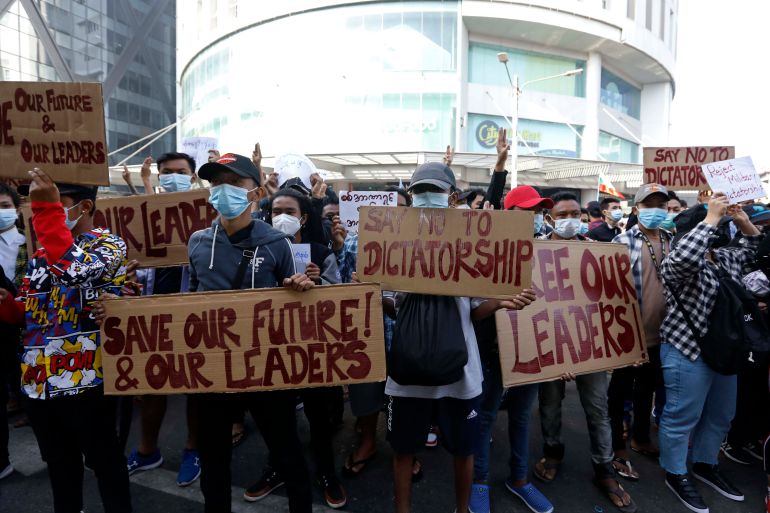
Yangon, Myanmar – As protests against the recent Myanmar military coup continue to rage across the country, the police response has grown more severe.
In Mandalay and Naypyidaw – the nation’s second-largest city and capital respectively – security forces have deployed tear gas, water cannon, rubber-coated bullets and even live rounds.
Keep reading
list of 4 itemsMyanmar protests continue after violence, raid on NLD office
New Zealand suspends Myanmar political, military ties after coup
Myanmar forces fire rubber bullets, warning shots at protesters
Naypyidaw police shot one 19-year-old woman in the head this week, leaving her on life support with a wound doctors say is likely to be fatal. The crackdowns have evoked memories of 1988 and 2007 demonstrations, when mass uprisings against military rule were brutally crushed, leaving hundreds and possibly thousands dead.
But many of the protesters leading the way are in their late teens and early twenties – some too young to remember even the violence of 2007. When they speak about why they are protesting, they talk about the future, not the past.
“They won’t put any budget in education and then will send their children to top-notch international schools,” said one 23-year-old who was out protesting on Wednesday in Yangon, Myanmar’s largest city, with a group of friends. Like many others, the protests had brought out the young men’s creativity. They were dressed in kimonos and carrying vulgar, humorous signs, including one mocking Senior General Min Aung Hlaing’s height.
But their reasons for protesting were serious. “The military will ruin everything for everybody but one percent of the population. They will leave everybody else uneducated and very poor. We’re worried that will be our future,” he said.
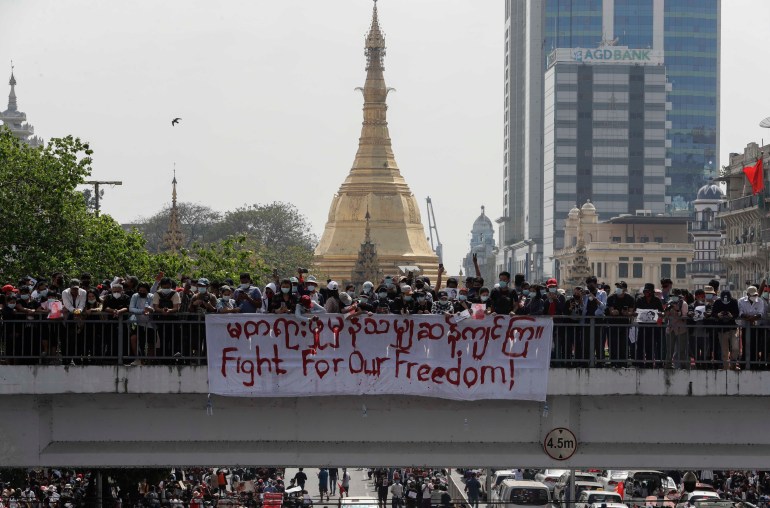
While the police in Yangon have so far refrained from using violence, protesters are all too aware of the risks.
“We are worried that could happen, but mostly we’re worried about the military taking control of the country again,” he said.
On February 1, the military overthrew the elected government, detaining State Counsellor Aung San Suu Kyi, President Win Myint, and leaders of the ruling National League for Democracy (NLD), which won a landslide victory in November’s election.
Mass protests kicked off on February 6 and have continued every day since.
‘Revolution’
While the military has hinted at a more serious response in Yangon, there has been no significant clampdown even as repressive threats issued have risen. On Tuesday, state-owned media outlets released an ominous warning that those “disturbing the stability of the state, the safety of the public and the rule of law should be countered by effective measures”. Soon after, all of mainland Yangon was placed under section 144: a total ban on protests, a ban on gatherings of more than five people, and a nightly curfew from 8pm to 4am.
That same day, thousands of protesters squared off with police at Hledan Center, near Yangon University, where young people have dominated the demonstrations even more so than in other parts of the city. Wearing ponchos and raincoats, the protesters faced a heavily armed police line buttressed by water cannon, ignoring repeated warnings to disperse. Despite the threats, the water cannon were never used.
One group of protesters who came prepared was seen on Tuesday with helmets, goggles, and face masks in anticipation of possible tear gas use or other methods. “We have to be prepared,” said a 22-year-old who gave part of his name, Aung. “This is the revolution of our citizens. We think the police might react soon. I heard one person has been shot in Naypyidaw.”
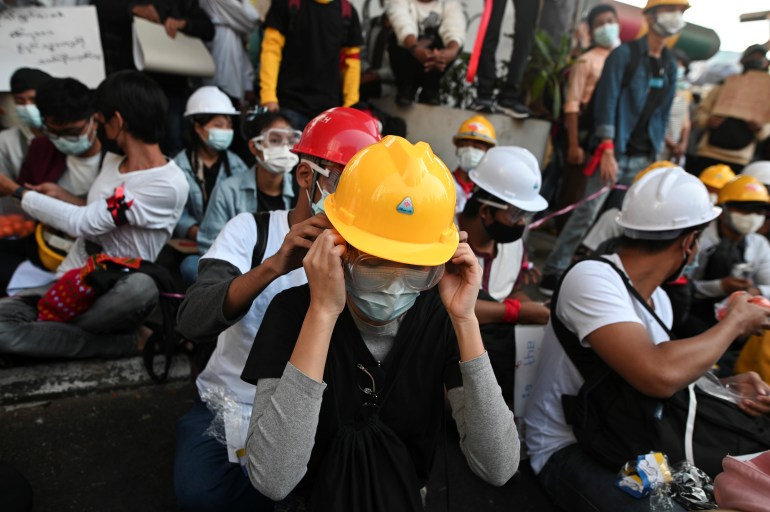
“It’s not right, it’s dangerous for us. They shouldn’t shoot, we are just protesting peacefully,” Aung continued. But the incident only left him more resolved. He and his friends drew up maps and handed them out to other protesters, showing locations around the centrally located Sule Pagoda where people could access medical care, water, food and toilets.
Others agreed that while the threat of violence was real, they were prepared for it. “We are a little worried about that, but it’s OK, no problem. This is our future and we have to fight for that,” said another 23-year-old protester who identified himself as Saw.
While many young people barely remember the days of military rule, Myanmar’s generals know little else.
The NLD’s 2015 election victory is the anomaly in the country’s recent history.
The party also won decisively in 1990, but the military refused to recognise the results and Aung San Suu Kyi spent the following years in and out of detention and house arrest.
The only other remotely free election was in 2010, which the NLD boycotted due to the controversial military-drafted 2008 constitution, which grants the military continued political representation, including 25 percent of the seats in parliament.
Spectre of violence
Younger people have tended to dominate the front lines of the protests but there are many members from older generations participating as well. Sailor Ye Win, 40, led the seaman union in kicking off protests at City Hall on Tuesday, amplifying his already booming voice through a megaphone as he chanted for democracy.
“Of course, I worry about violence because the military government is always shooting people,” he said.
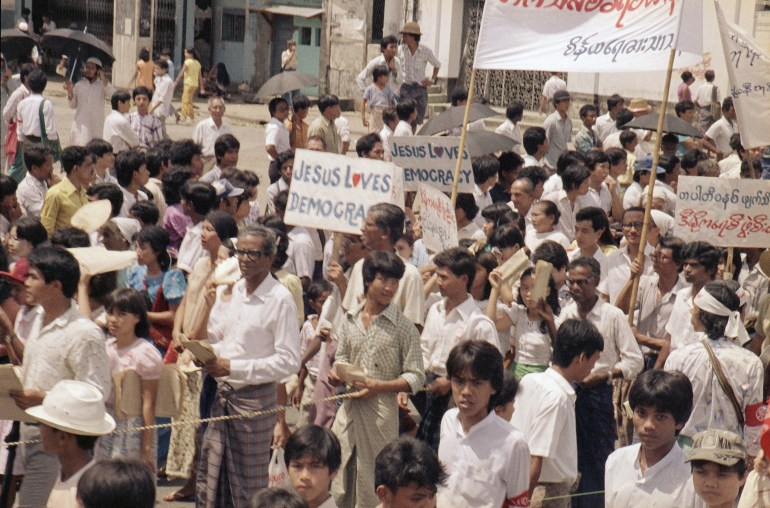
This fear has not stopped him from going on strike alongside other sailors, taking to the streets to demand an end to military rule. Ye Win was a small child in 1988 and an adult during the Saffron Revolution in 2007, but said he remembers both clearly. “In 1988 they killed so many,” he said.
Some, like an 18-year-old protester born in 2002, are too young to remember either crackdown.
He stood with a small group of protesters late on Tuesday afternoon, after most had already gone home for the day, chanting directly to a group of police officers, and encouraging them to join the protests.
“We want our justice, we want our democracy back, and we want the release of Daw Aung San Suu Kyi,” he said, telling Al Jazeera it was his third day in a row appealing to the police.
When asked if he was afraid of any violent response, he laughed. “No, I’m not afraid of the police. I love them. I want them to join us,” he said.
Most view the possibility of violence more realistically, like a 28-year-old who was out protesting with his 21-year-old sister on Wednesday.
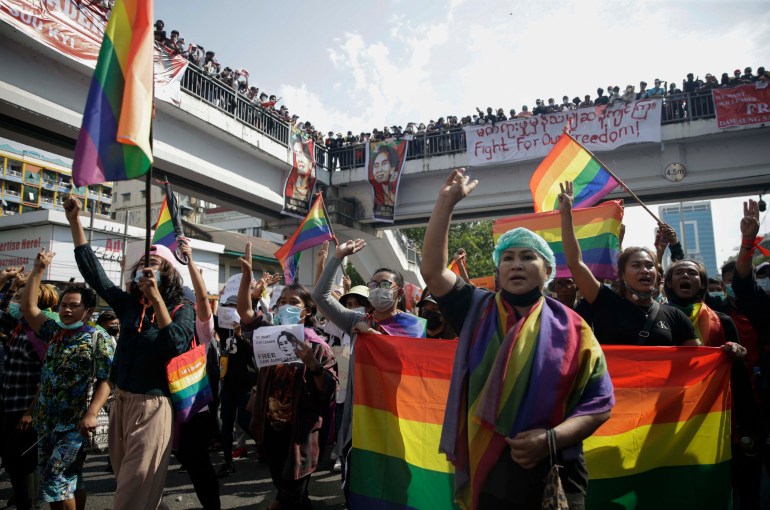
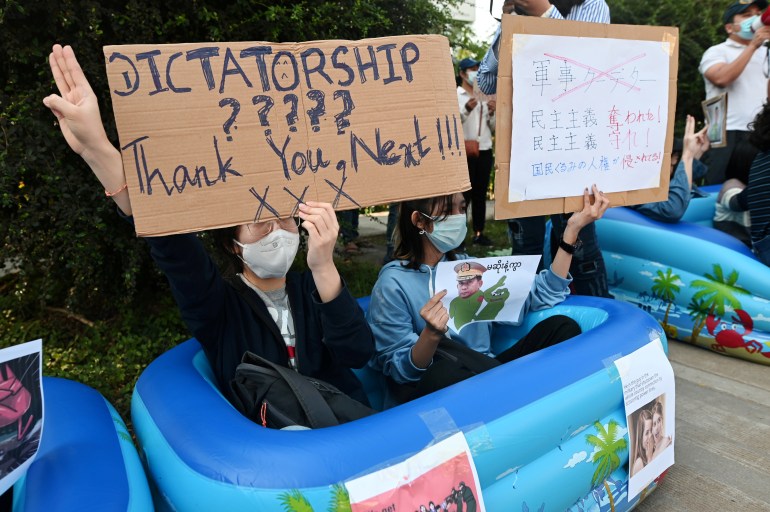
“We cannot give up on this issue because our future is in their hands. There are a lot of democratic countries in the world and we want to be one of them,” he said.
When asked, he said he vaguely remembered the Saffron Revolution and the violent military response.
“In Naypyidaw and Mandalay they already hurt people,” he said. “Maybe 100 people or 1,000 people could die, but our whole future depends on this moment, If we don’t win, we will be a slave to the military forever.”